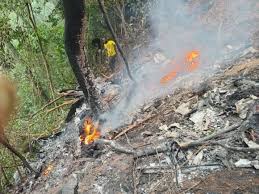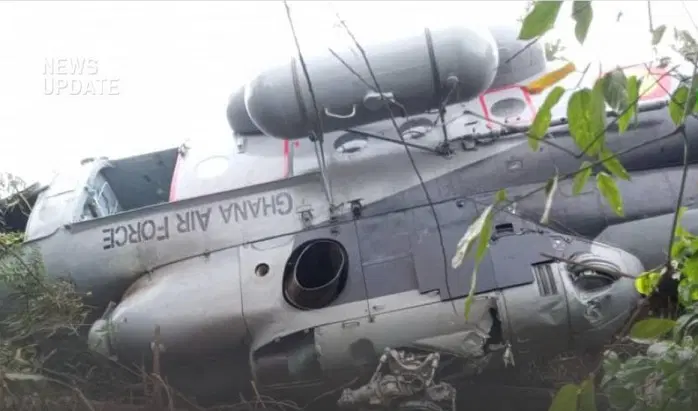The fatal helicopter crash involving military aircraft GHF 631 has sparked serious questions about the country’s preparedness for aviation emergencies, especially Search and Rescue (SAR) practices.
Bright Simons of IMANI Africa indicated that the tragedy has drawn unprecedented public interest, prompting him to take on an investigative role to examine what might have gone wrong.
His first step was to try to understand the terms of reference and scope of the investigative board of inquiry set up by the President.
However, official sources have been tight-lipped, and there have been no leaks of any provisional memoranda that could provide insight beyond what is already public.
Simons noted that the nation will have to wait for the final report, but without knowing what questions the investigators are asking, the public remains in the dark.
One troubling observation he intends to watch closely relates to the breakdown of Ghana’s Search and Rescue (SAR) protocol. According to Simons, “from the public record, it is clear that Ghana’s Search & Rescue (SAR) Protocol broke down completely in the aftermath of the Z-9EH’s crash.”
The protocol in question covers a range of procedures. A military aircraft carrying very important persons (VVIPs) would typically be equipped with an Emergency Locator Transmitter (ELT) beacon transmitting on the 406 MHz frequency.
On impact, this beacon should automatically activate and send a signal to the global Cospas-Sarsat satellite network, which is internationally coordinated by ICAO and IMO. Ghana hosts a Rescue Coordination Center (RCC) in Accra, while its Mission Control Center (MCC) is based in the United Kingdom.

Simons pointed out that “Ghana purports to be compliant with the ELT standard called Global Aeronautical Distress and Safety System (GADSS)” and claims to have capabilities for Autonomous Distress Tracking (ADT).
In theory, the crash should have triggered an immediate signal to the MCC and RCC. From there, institutions such as NADMO, the Ghana Maritime Authority, the 37 Military Hospital, and the Ambulance Service should have been activated without delay.
Instead, Simons noted that the system failed to function as designed. A backup measure, the personal locator beacon (PLB) transmitting on 121.5 MHz, also did not result in timely action.
This redundancy is meant to initiate the Ghana Air Force’s “flight following and tracking” procedure, especially when radar contact is lost and the aircraft fails to arrive on schedule.
A System Perfect On Paper, But Not In Practice
Bright Simons also added that if the system had functioned as intended, the ELT signal, together with GPS coordinates, would have enabled responders to quickly locate the crash site.
This, he stated, would have allowed a coordinated team to secure the area, initiate evacuations, and recover debris.
Instead, the entire chain of response collapsed, leaving untrained local residents to handle the initial rescue attempts, while disorderly and uncoordinated scenes played out live on social media.

Simons asserted that the inquiry should clarify how and why the framework failed so completely, allowing several hours to pass before trained personnel reached the site.
He pointed out that by that time, crucial evidence had vanished, and any survivors would likely have succumbed before receiving medical assistance.
“What I can predict for sure is that most of these things only operate well when the POLICY level of national systems has a large enough audience for there to be accountability about things that are seemingly dry and technical, but have huge significance. In Ghana, all the emphasis is on political accountability.
“There is practically no audience for policy accountability. A lot of vital and critical things thus fly under the radar, excuse the bad pun, until there is a system failure. This is another feature of my katanomics theory.”
Bright Simons
He drew attention to the Ghana Armed Forces’ plan to spend nearly GHS 700 million between 2025 and 2027 on “forward operating bases,” awarding contracts to companies previously linked to controversial projects.
There has been little debate about whether spreading resources across smaller, under-equipped bases is sensible when major installations still require upgrades.
Poor Resources Slow Helicopter Crash Response
Meanwhile, the crash occurred in an area under the responsibility of the Air Force’s Bui Tactical Command.
Simons described this outpost as severely under-resourced, with no functional aircraft, unreliable internet, and little incentive for personnel to be stationed there. Despite this, plans are underway for another mini-base near Bamboi, also unlikely to be fully equipped.

He questioned why Kumasi, which already has adequate military infrastructure, has not been developed into a major operational hub.
Stationing aircraft, paratroopers, and radar systems there would enable rapid response to incidents in the middle belt, well within the one-hour target in Ghana’s SAR manual.
Instead, Simons noted that, “the military couldn’t even get to Adansi Brofoyedu within 3 hours of the aircraft being declared missing. Not even within 7 hours.”
The broader policy challenge, he stated, is creating a public that is engaged with these operational questions before a crisis forces them into the spotlight.
For now, Simons will be watching closely as the inquiry unfolds, ready to share any developments that raise issues of national policy and preparedness.
READ ALSO: Reeves Urges Public Patience On Economic Turnaround























